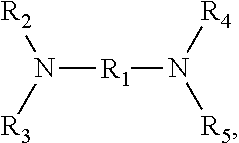Polymers polymerized from at least four monomers, and compositions and uses thereof
a polymer and monomer technology, applied in the field of non-homopolymers, can solve the problems of limited selection of polymers soluble, lack of alcohol-soluble polymers, and multiple challenges faced by formulation scientists
- Summary
- Abstract
- Description
- Claims
- Application Information
AI Technical Summary
Benefits of technology
Problems solved by technology
Method used
Image
Examples
example 1
Synthesis of poly(21.1% VP-32.5% AA-41.2% IBMA-5.3% IBOMA)
[0312]
[0313]An autoclave reactor was loaded with a solution of N-vinyl-2-pyrrolidone (13.33 g), acrylic acid (13.33 g), isobutyl methacrylate (33.33 g), and isobornyl methacrylate (6.67 g) in ethanol (68.00 g). The mixture was heated to 80° C. under nitrogen with mechanical stifling at 200 rpm. At this time a pump was filled with a mixture of N-vinyl-2-pyrrolidone (26.67 g), acrylic acid (26.67 g), isobutyl methacrylate (66.67 g), and isobornyl methacrylate (13.33 g). At t=0, t-amyl peroxy-2-ethylhexanoate initiator (Trigonox 121, Akzo Nobel) (0.30 g) was charged into the reactor to initiate the polymerization. Then, the contents of the pump were emptied into the reactor at a constant rate over the next 3 hours. Additional shots of the initiator were added at t=1, 2, 3 hour (0.30 g each). The reaction temperature was then raised to 91° C. at t=5 hour and additional initiator was charged at t=5 and 8 hours (0.60 g each). After...
examples 2-5
Synthesis of Other poly(VP-AA-IBMA-IBOMA) Polymers
[0314]The method of Example 1 was substantially repeated to yield other non-homopolymers of differing monomer ratios (Table 1). All polymers were soluble in ethanol at 50% solids (w / w).
TABLE 1Poly(VP-AA-IBMA-IBOMA) polymersmonomer contentmonomer content(mole percent)(weight percent)Ex.VPAAIBMAIBOMAVPAAIBMAIBOMA110.833.350.65.410206010211.134.343.511.1110205020316.233.442.38.115205015421.132.541.25.320205010521.132.541.25.320205010
examples 6-8
Synthesis of poly(VCL-AA-IBMA-IBOMA) Non-Homopolymers
[0315]
[0316]Examples 3, 4, and 5 were substantially repeated, replacing VP by an equal amount of N-vinyl-2-caprolactam (VCL) on a weight basis (Table 2). As in Examples 2-5, the polymers of Examples 6 and 7 were made in ethanol and were soluble in the final product at 50% solids (w / w). The non-homopolymer of Example 8 was synthesized in acetone, and created a cloudy product mixture.
TABLE 2Poly(VCL-AA-IBMA-IBOMA) polymersmonomer contentmonomer content(mole percent)(weight percent)Ex.VCLAAIBMAIBOMAVCLAAIBMAIBOMA613.434.543.78.415205015717.633.943.05.520205010817.633.943.05.520205010
PUM
| Property | Measurement | Unit |
|---|---|---|
| glass transition temperature | aaaaa | aaaaa |
| Tg | aaaaa | aaaaa |
| Tg | aaaaa | aaaaa |
Abstract
Description
Claims
Application Information
 Login to View More
Login to View More - R&D
- Intellectual Property
- Life Sciences
- Materials
- Tech Scout
- Unparalleled Data Quality
- Higher Quality Content
- 60% Fewer Hallucinations
Browse by: Latest US Patents, China's latest patents, Technical Efficacy Thesaurus, Application Domain, Technology Topic, Popular Technical Reports.
© 2025 PatSnap. All rights reserved.Legal|Privacy policy|Modern Slavery Act Transparency Statement|Sitemap|About US| Contact US: help@patsnap.com



